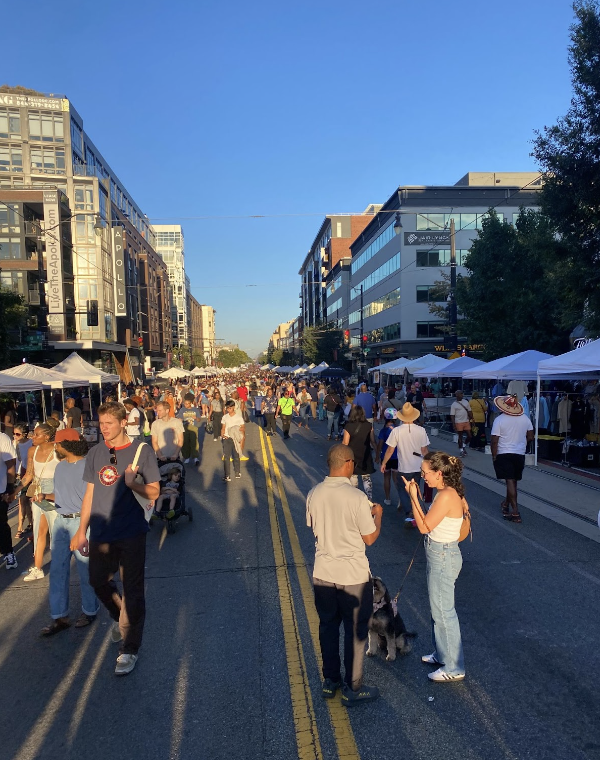H Street welcomed more than 150,000 people to Northeast Washington, D.C. to celebrate the 18th annual H Street Festival on Sept. 16, showcasing local art, food and culture.
This festival, which spans 11 blocks of the historic street, hosted diverse vendors and performance groups demonstrating dance, fashion and music. Since its founding in 2005, the festival has provided opportunities for local businesses and drawn tourists to the area, boosting the H Street Corridor’s economy.
At the festival, musicians performed Go-Go music, a funk genre that Black Americans first created in D.C. in the 1960s and 1970s. H Street featured 14 stages to showcase the music, with line-ups of bands and music groups including A.F.R.O.B.A.M., HORU Music Experience and Blacc Print Experience Band.
Jack Markowitz (CAS ’27), a newcomer to D.C., said he attended the event to experience other neighborhoods of the city beyond campus and Georgetown.
“The community shined through,” Markowitz told The Hoya. “It felt like a safe place for everyone in the community. The music was loud, and the scents, and seeing everything — it was a very visceral experience.”
H Street, once an affluent neighborhood, was the site of riots following Martin Luther King Jr.’s assassination in 1968. The H Street Festival began in 1985 in an unofficial capacity in a neighborhood still facing the impact of riots, with only around 500 people attending it in 1987.
In 2005, the H Street Festival was stabilized. The nonprofit H Street Main Street now runs the festival, allowing visitors and residents to explore the neighborhood’s diverse cultural and food offerings.

Anwar Saleem, the executive director of H Street Main Street, said the festival gives a boost to the local economy as D.C. residents come from across the city to attend.
“It’s like Black Friday for many businesses. It’ll be the strongest day for them economically,” Saleem told DC News Now. “This will also give people a chance to highlight what we have. We have a lot of new businesses open. A lot have closed, but a lot have opened and it gives people a chance to come down here and discover how much we’ve grown.”
Nadia Garcia, a Peruvian entrepreneur based in D.C., sold Peruvian hand-made woven art and apparel under her company Artesana Love. Garcia said that this year was her first as a vendor at the H Street Festival.
“Last year, after the pandemic, I left my job and decided to do something meaningful with my experience and the fact that I’m here, and I decided to start my small business,” Garcia told The Hoya. “I haven’t been in D.C. at a festival so vibrant in a while.”
The festival has been successful in growing the neighborhood, helping to reduce the commercial building vacancy rate from 75% to under 5%, according to festival organizers.
Markowitz said understanding H Street’s revival allowed visitors to recognize its place in the larger context of D.C.
“I would say it played a big role on my desire to return to H Street to experience the culture in action,” Markowitz said. “It also made me more aware of the magnitude of impact that having a festival like this that brings people to H Street to shop, eat and support the businesses has on this neighborhood and community. It made me want to shop locally and support the businesses there.”
Markowitz said that he enjoyed listening to the demonstration of Go-Go music.
“I think that it earns its name,” Markowitz said. “It gets you jamming and grooving, and I think that it’s a great unifier because everyone there is listening to the music and it’s fun.”
A diverse range of local businesses also sold food at the festival, including Ethiopian street food and crab. Markowitz said that he sampled the international cuisine by purchasing a Caribbean vegetable bowl from a restaurant on H Street.
“It wasn’t a variety of the same type of cuisine; it was all sorts of cuisines. There were so many different varieties of cuisine from all over the world,” Markowitz said.
Markowitz said the businesses and musicians at the festival showcased D.C.’s diverse culture.
“I think it exemplifies how much diversity there really is in D.C., and you almost don’t even see it because it’s all over,” Markowitz said. “It was concentrated within this one area, which was a really cool experience to be able to see. I hope everyone can go and see it, too.”














